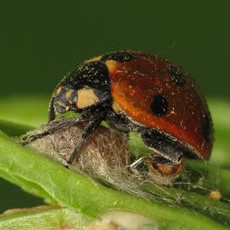The idea of parasites manipulating their hosts for their own benefit has always been a tough one to grasp. I have even discussed previously on this blog the importance of finding the mechanism of manipulation so we do not incorrectly interpret the hosts altered behaviour as being caused by the parasite. This is very tough work and the answers unknown for many parasites although there is evidence for some genes and neurotransmitters involved. However, for one host-parasite system a new, third, party has been discovered that may be the cause of host subversion.
This story is a fascinating one because it involves parasitoid insects, which are known to be spectacular manipulators. Parasitoids lay their eggs onto or in a host which then serves as a food source and house for the developing larvae. The most well-known types of parasitoids are wasps and they often use venom or other substances to change their hosts’ behaviours in a variety of ways, including what is known as body guarding behaviour (check YouTube for some crazy videos). In this situation the host stands guard over the pupating insects after they have crawled out of its body to form cocoons. The fact that the host displays this weird behaviour once the parasitoid is no longer in physical contact suggests that some chemical or venom has been injected and continues to affect the host. New research has shed light onto this mystery manipulating substance and the result, as is often the case, is not so simple.
The parasitoid wasp, Dinocampus coccinellae, lays eggs inside of its host, Coleomegilla maculate, commonly known as the spotted lady beetle. The eggs develop inside the host, emerge and pupate next to the host. These little wasp larvae cocoons would be vulnerable to predators if it were not for the bizarre trait of the host standing guard over them. The beetle will stand motionless, save for the occasional tremor, over top of the pupating wasps, protecting them, until they have fully transformed and flown away.

Photo by David Gould
http://www.naturespot.org.uk/species/dinocampus-coccinellae
Variations of this are seen in other host-parasitoid interactions but this is different for a couple of reasons. One being that after the wasps have flown away the beetle recovers regains mobility and walks off. In many other situations the bodyguard host dies soon after the adults emerge, the second being that a virus may be responsible for this bodyguard behaviour.
A recent paper from a team of researchers based in France and Canada have found a new RNA virus, Dinocampus coccinellae paralysis virus (DcPV), associated with the two players in this interaction. The virus was found in oviducts of the adult wasps, it replicates in the larvae which then transmit it to the beetle. In the beetle the virus infects nervous tissue causing neuropathy and an associated immune response. It is this action that can then cause the bodyguard behaviour which in fact is a symptom of infection: paralysis. Then after clearance of the virus normal behaviour is restored.
This research implies for the first time a third player in host manipulation rather than the parasite itself regulating the manipulation. The authours describe this phenomenon as a “biological weapon” being used by the wasp and highlight the many fascinating questions this raises. Does the virus actually gift the wasp with some fitness benefit, meaning are un-infected wasps and larvae as successful in contributing to the next generation? What is the relationship between the virus and the wasp, symbiotic? If so what is the benefit to the virus. It could be that the virus itself needs the presence of the beetle as it seemed that replication occurred in the larvae within the beetle and in the beetle itself as opposed to within the adult wasp. The nature of the timing of viral replication and clearance with the development time of the larvae suggests that this would be a symbiotic interaction that has evolved over time.
The role symbiotic or parasitic relationships play in the overall biology and ecology of organisms is an interesting one and has been shown before to have profound effects on the life histories of hosts. The bacterium Wolbachia infects many insect families and the relationship it has with its many hosts ranges from parasitic to mutualistic. This bacterium can alter the sex ratios of a population by killing males, feminizing males or inducing parthonogenic reproduction. In some cases the presence of Wolbachia is a good thing as it protects some hosts from RNA viruses, similar to DcPV. It also produces chemicals necessary for survival in other hosts.
These third party interactions illuminate the complexity of biological systems and host parasite interactions. How often does this occur in behavioural manipulation scenarios? How did they evolve and what potential fourth party may be influencing the outcome of the third party interaction? It also forces one to reconsider the concept of host manipulation, as discussed in other articles, are these truly adaptive manipulations or by products of infection; in this case not just infection with one parasite but a parasite of the parasite. The unraveling of nature’s complex interactions is never quite straightforward and this research has wonderfully added to that complexity.
“The complexity of things-the things within things-just seems to be endless. I mean nothing is easy, nothing is simple.” -Alice Munro
By Brad van Paridon
Original Paper:
